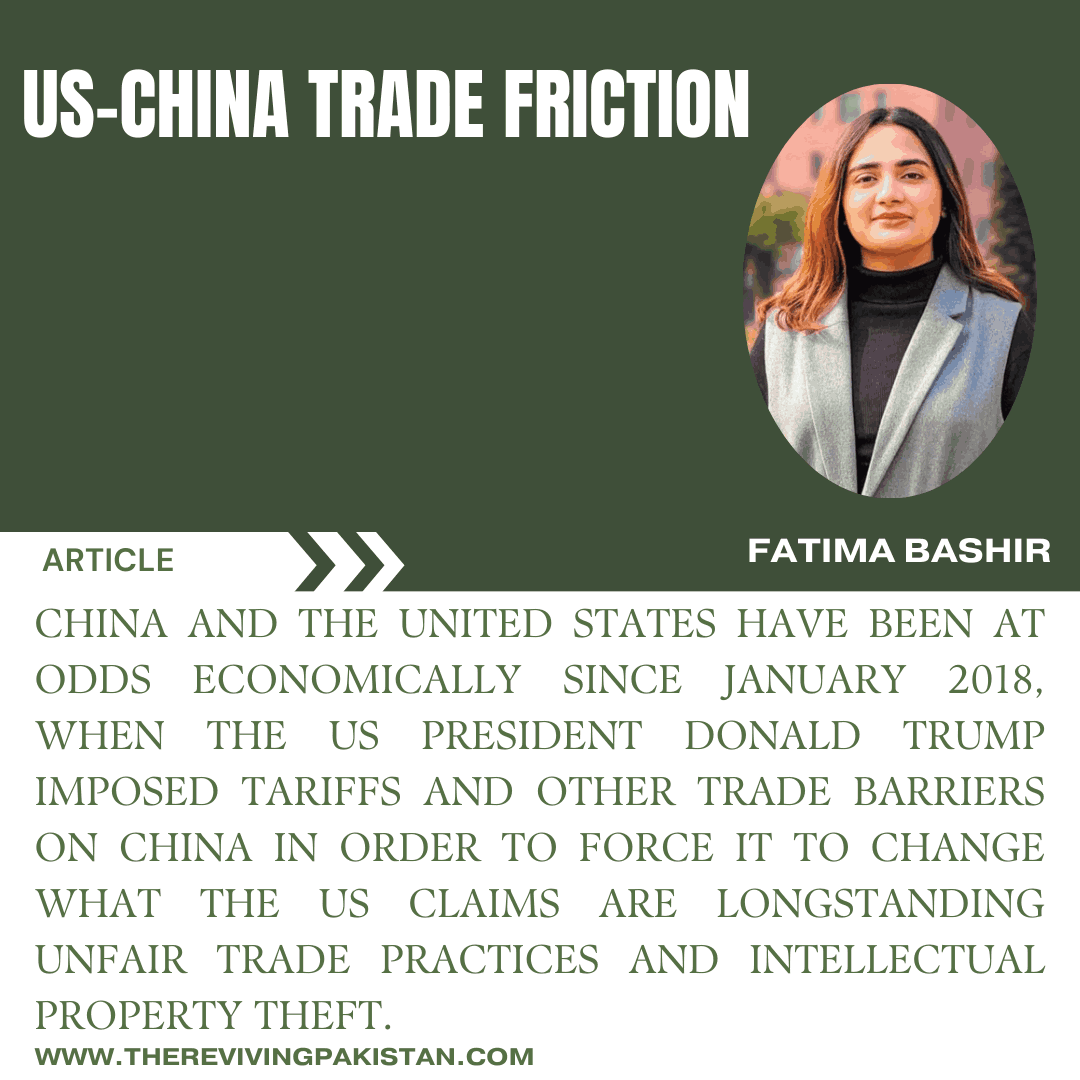
Fatima Bashir
The author is a student of international relations at the University of Central Punjab. She has a passion for law and politics and stays up-to-date on current events. She enjoys exploring the connections between global issues and how they impact our world.
China and the United States have been at odds economically since January 2018, when US President Donald Trump imposed tariffs and other trade barriers on China to force it to change what the US claims are longstanding unfair trade practices and intellectual property theft.
Trump’s administration states these changes can contribute to the US-China trade deficit. Since the 1980s, Trump has advocated for tariffs imposed on China to promote US domestic industry. He said the country was being “ripped off” by its trading partners. Many economists who surveyed Trump’s policy of tariffs criticized it, saying that it would do more harm to the country than good. Others suggested alternative options to deal with the trade deficit problem. American proponents of tariffs on China suggest that imposing these on China will bring manufacturing jobs to the US if bilateral tariffs are reciprocated and that China should change several policies regarding trade. But still, most economists are skeptical of the ability of tariffs to bring about such big changes. According to a report, $105 billion was spent in China by American businesses in 2019, and 1.2 million American employments are supported by exports from the United States to China in addition to 197,000 American jobs directly held by Chinese multinational corporations.
Economists’ research on trade with Chinese multinational corporations has produced mixed results. Instead of trade policy, most economists think that macroeconomic variables are to be blamed for the US trade imbalance. The phenomenon known as Trade DIVERSION predicts that while higher taxes on Chinese goods will likely reduce the US imports from China, they will also likely boost imports from other nations, maintaining the US trade imbalance.
China’s economic reforms in the 1970s increased the trade between the USA and China, and it increased even more when China entered the WTO during Barack Obama and George. W. Bush administration, even though many tariffs, trade barriers, and anti-dumping accusations were still in place, US-CHINA trade relationships flourished. During this time, China’s economy grew to be the second largest economy, and many great projects, such as CPEC, MADE IN CHINA 2025, and ASIAN INFRASTRUCTURE BANK, started. This made US policymakers a bit insecure. The US has imported more goods from China than it has exported to China. This is one of the primary reasons for the US trade deficit. The US trade deficit rose to almost 375.6 billion dollars in 2017. Another reason is the difference in saving rates between the USA and China. Chinese households save more than 30% of disposable income on average, compared to the US, which is at 7%.
The United States has long criticized China’s trade policies, particularly its inflexible exchange rates, which are deemed unfair and detrimental to American businesses. Additionally, the US has repeatedly expressed concerns over China’s human rights records. These concerns have resurfaced on the trade agenda in recent years with reports of forced labor in Xinjiang, where China is repressing millions of Uyghurs. Beijing’s 2020 national security law, which fundamentally altered Hong Kong’s freedoms, is another source of tension. Experts say the law could make foreign firms hesitant to do business in the city, jeopardizing its standing as a global financial hub. The rival economic systems of the two countries are central to the trade conflict. As journalist Paul Blustein describes in his book Schism: China, America, and the Fracturing of the Global Trading System, Chinese officials first enthusiastically followed WTO regulations, resulting in a fundamental restructuring of the economy and legal system. However, despite significant economic liberalization, which resulted in a thriving private sector, China never fully embraced the invisible hand of the market.
The Chinese Communist Party governs the economy through centralized management of state-owned firms, control over financial institutions, and a powerful economic planning commission. China’s leaders say their system is necessary to improve the lives of the Chinese people and is in line with the financial strategies used by Western countries at similar stages of development. According to CFR’s Jennifer Hillman, Beijing has perfected the technique of acquiring Western technology, developing Chinese enterprises into giants, and then unleashing them onto the global market, at which point international companies cannot compete. Hillman mentions 5G networks as an example of a Chinese-dominated industry. “You start to see how big a problem it is to try to live in this world in which China owns more and more markets, and you can’t get in,” she reflects. Not only has the United States been the most strident critic of Chinese trade policies, but other countries, such as the European Union (EU) members and Japan, have also shared these worries.
Protectionist Mindset:
Taiwan produces about 90% of the world’s most advanced semiconductors, mostly through the Taiwan Semiconductor Manufacturing Co Ltd (TSMC), the world’s largest producer and a major Apple and NVidia supplier. The United States government has been actively encouraging TSMC to establish a manufacturing presence in the country. China has faced accusations of intellectual property theft from numerous countries and has been known to replicate various products. Due to its history of copying and lack of indigenous innovation, many nations are concerned about protecting sensitive technology. This is particularly evident in the heightened security measures, including naval protection, surrounding Taiwan Semiconductor Manufacturing Company (TSMC), a leading independent semiconductor foundry. These measures safeguard TSMC’s cutting-edge technology and intellectual property from potential Chinese theft. The West is taking collective action against China. Canada and the EU have imposed tariffs on China’s electric vehicle (EV) industry. However, China plays a clever game as a communist nation with state-run industries. It subsidizes its industries to create a flood of products circulated globally at cheap prices, thereby reducing prices in international and local markets.
China’s Response:
The Chinese government has responded to these actions by asserting that they are designed to hinder China’s economic growth. The trade war has had a profoundly negative impact on the global economy. They blamed the US for starting the conflict and stated that these measures have complicated negotiations, making it difficult to find a mutually beneficial solution. China’s representative of WTO said that the US representative was operating with a presumption of guilt based on speculations with no objective evidence. The former US treasury found that Chinese technological success is not the result of some theft but colossal government investment in basic science.
Biden’s Administration’s Restrictions:
The Trump-era import taxes on goods from China have not been lifted by the Biden administration as of September 2022. To protect US economic and military interests, the Democratic administration has instead imposed new export restrictions and investment prohibitions on Chinese enterprises. The US Department of Commerce increased penalties against 50 Chinese firms in October 2022. Among them was Huawei, a telecom equipment manufacturer linked to the June 2021 incident.
Furthermore, NVidia, Yangtze Memory Technologies (YMTC), and ChangXin Memory Technologies—manufacturers of chips—were subjected to export restrictions. Among other Chinese businesses, the penalties also targeted BGI Genomics, a genomics company, and DJI, a manufacturer of drones. However, South Korean telecom companies’ trade with the PRC was partially protected from the new regulations.
The Biden administration updated regulations on March 29, 2024, to limit China’s access to American artificial intelligence (AI) chips and tools for creating chips, such as those made by NVidia. This move was made in response to national security concerns that Beijing’s technological advancements might be used to support its military.
WHAT IS THE FUTURE OF THIS CONFLICT?
A November 2019 United Nations Analysis stated, “US tariffs on China are hurting both countries.” By late 2019, the US had imposed approximately 350 billion dollars in tariffs on Chinese imports, and China had imposed 100 billion dollars on US exports. Biden’s eagerness to escalate the economic conflict with China has sparked concerns about the future of the trade relationship. Neither US tariffs on Chinese imports (or retaliatory Chinese tariffs on US exports) nor US export controls have shown signs of being reduced. Some legislators have offered proposals to broaden Biden’s investment limitations to encompass other Chinese businesses, while others propose legislation requiring federal government investment plans to divest from Chinese corporations. The trade conflict in China exacerbated a downward trend in the country’s already diminishing industrial and economic production growth pace. There are concerns that the trade war may cause the US and Chinese economies to “decouple” due to the relocation of many American companies’ supply chains to other parts of Asia. While some nations profited from greater manufacturing as production was moved to them, the trade war has also negatively impacted the economies of different countries. Stock market volatility was another result. To mitigate some of the harm brought forth by the economic battle, governments everywhere have taken action.
Conclusion:
A pivotal moment in the strategic struggle between the two superpowers of the globe is represented by the trade tensions between the US and China. Their trading relationship has become a major battleground as both countries compete for geopolitical, technological, and economic influence. A more sophisticated understanding of each other’s interests, goals, and restrictions is necessary for the US and China to reduce the dangers of growing tensions and advance a stable and prosperous future.

